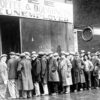DOL independent contractor definition could pose problems for truck fleets
![]()
DOL independent contractor definition could pose problems for truck fleets
Proposed rule’s stance on providing equipment, regulatory direction seen as potentially problematic
John Kingston Follow on TwitterMonday, October 17, 2022
7 minutes read

Listen to this article
0:00 / 9:271X
The more than 160-page proposed rule on defining independent contractors now up for comment by the Department of Labor has a few provisions that transportation attorneys believe could be a problem for transportation companies.
While the proposed rule may be hefty in size, it does not include a great deal of specificity. (The words “truck” and “trucking” only appear once each.) This new DOL rule would replace a Trump administration rule still in effect after a court decision reinstated it after the Biden administration tried to yank it.
But a discussion of where the DOL stands on two particular issues — regulation compliance and equipment — could be seen as having potential impacts that may end up favoring a conclusion that a driver is an employee rather than an independent contractor in actions before the Wage and Hour Division of the DOL.
Greg Feary, a partner with the trucking-focused Scopeletis law firm, said the DOL’s comments on aiding regulatory compliance is “the big ticket item” for trucking and transportation.
“They don’t specifically say that they think if you’re an operation in a highly regulated environment that your workers can’t be independent contractors,” Feary said. “But they are leaning in that direction.”
The DOL wrote in explaining its views that “an employer’s compliance with legal obligations, safety or health standards, or requirements to meet contractual or quality control obligations, for example, may in some cases indicate that the employer is exerting control, suggesting that the worker is economically dependent on the employer.”
Feary said modern safety technology, used to assist in regulatory compliance, provides numerous avenues for a legal action to conclude that an employer “controls” an independent contractor. And in the “economic realities test,” which is the basis for the proposed rule, “control” is a very big issue.
For example, while all trucks are required to have ELDs, Feary noted that they aren’t required to have safety equipment that is increasingly deployed such as cameras. “Now all of a sudden you have the DOL making somewhat of a suggestion that things like cameras and GPS systems could be a sign for employment control,” he said.
The end result, Feary said, could be a small carrier not investing in that type of equipment so as to not risk having a lawsuit or Wage and Hour action against it conclude that an independent driver is “controlled” by the fleet as defined by the DOL rule.
Jessica Scott, an employment attorney with the Denver law firm of Wheeler Trigg O’Donnell, said the provision regarding regulatory assistance is “what frustrated me the most about the proposed rule.”
“It has been pretty well settled for decades that if you are talking about something that is mandated by the government, like a DOT regulation, that is not considered employer-type control,” Scott said. “This has now flipped.”
In contrast to Scott’s statement that an employer ensuring that an independent contractor stays true to regulatory standards can be viewed as truly independent, the proposed rule takes a different approach.
“The Department believes that the nature and degree of the employer’s control should be fully assessed, and this assessment may, in some cases, include consideration of control that is due to an employer’s compliance with legal, safety or quality control obligations,” the proposed rule says.
“When an employer, rather than a worker, controls compliance with legal, safety or other obligations, it may be evidence that the worker is not in fact in business for themself because they are not doing the entrepreneurial tasks that suggest that they are responsible for understanding and adhering to the legal and other requirements that apply to the work or services they are performing such that they are assuming the risk of noncompliance.”
Marc Blubaugh, head of the transportation practice at the Benesch law firm, noted that the Trump administration in its final days had published a letter making clear that a carrier requiring its independent owner-operators to meet regulations was not a sign of control.
“This makes good common sense,” Blubaugh said in an email to FreightWaves of the Trump DOL’s approach. “This new proposed rule effectively takes a 180-degree turn and provides the opposite. The DOL rationalizes its approach on the basis that it has now performed a ‘thorough review of relevant case law’ and has changed its position ‘upon further consideration.’ Call me skeptical. DOL essentially cherry-picked outlier cases to provide a patina of justification.”
The economic realities test is a wide-ranging legal precedent that is often used in government actions or lawsuits to determine whether a worker is an employee or an independent contractor.
That test is not new to the DOL — the current Trump rule is based on it. It’s a list of determining factors that touch on issues of how integral the independent contractor’s work is to the employer’s business; investment; control; the opportunity for an independent contractor to profit or lose money depending on performance; the amount of initiative the independent contractor can or must take; and how permanent the relationship is. None of them are what attorneys call “dispositive,” in which a finding regarding one of these factors settles the issue. Nor do all six need to be determined to favor one side or the other. Courts and regulatory agencies can weigh the relative importance of any or all of them.
However, the Trump administration rule does lift two of the six prongs above the others: an employee’s degree of control over the work and the worker’s opportunity to profit if he or she showed initiative and drive. In determining whether a worker is an employee or independent contractor, those two tests were more important than the other four.
The second key area of concern is the suggestion by DOL that an investment by a worker in capital equipment — like a truck — is not conclusive under one of the “economic reality” tests that the worker is indeed independent.
A reading of what the DOL wrote can be seen as ambiguous. “The Department believes that the worker’s investment should generally support an independent business or serve a business-like function, such as increasing the worker’s ability to do different types of or more work, reducing costs, or extending market reach, to indicate independent contractor status.”
But the DOL suggests other interpretations that could impact drivers. For example, a driver that works for a courier service using his or her own car, which would be indispensable to that business, could be seen as not having made an investment that matches the economic realities test since the car presumably would have been owned anyway. It also suggests it will look at the size of the individual worker’s investment relative to the company’s investments.
The reading of it by Feary was enough for him to conclude that “on the investment in equipment, that the purchase-leaseback program will be under attack by the DOL.” As that is a leading method of getting drivers seated in equipment and having them operate independently, it might be a key concern going forward.
Blubaugh said the DOL “is putting renewed emphasis on the worker’s investment in equipment required for the work.”
He stressed that the rule is not the end-all in defining independent contractor status. It is one of a multilayered piece of the regulatory structure.
“It is only relevant for purposes under the Fair Labor Standards Act,” he said. It has no impact on legal issues that impact workers compensation, unemployment or state laws. And there are independent contractor rules that are separately administered by the Internal Revenue Service and the National Labor Relations Board.
One of the more notable aspects of the DOL proposed rule is that it did not include the far more stringent ABC test, which is at the heart of California’s AB5 law. The ABC test is a three-pronged rule to determine independent contractor versus employee status. The B prong is particularly problematic for the trucking industry because it leans toward defining as an employee a worker who is engaged in the primary activity of the hiring company. A trucking company hiring an independent owner-operator could be seen as violating the B prong.
Frederick Yarger of Wheeler Trigg O’Donnell said the department believed that based on earlier Supreme Court precedents, it was not empowered to implement the ABC test as the basis for determining independent contractor status.
He conceded the ABC test does have “simplicity,” which is replaced by the “flexibility” of the new proposed rule. But with flexibility also comes a lack of clarity, Yarger added.
Asked about how the new rule will be enforced, Yarger said it will “empower the Wage and Hour Division to take test cases and push this rule in whatever direction they want it to go.” He added that “it will be the agency interpreting the statute and telling a court how to address it.”
As Richard Reibstein wrote on his blog, which is focused specifically on independent contractor law, companies “cannot help but be perplexed by the back and forth and back again at the Labor Department from one administration to the next and then to the following administration.”
And while Feary said the proposed rule “shows the Department of Labor has a thumb on the scale leaning toward employment,” Reibstein was cautious about the impact of the rule.
“The courts, not regulatory bodies, have the final say on who qualifies as an independent contract and who does not,” he wrote on his blog. “While courts are expected to give deference to valid regulations, that is not a given where regulations keep changing, especially where courts agave already issued an abundance of decisions on a particular subject.”
More articles by John Kingston
Brokerage solution to California’s AB5 rule gets support from Cowen panel
Truck transportation jobs walloped in September: BLS data
Come on in: what it’s like at an ABF/ArcBest hiring event
The FREIGHTWAVES TOP 500 For-Hire Carriers list includes ArcBest (No. 26).
AB5 Department of Labor gig economy Wage and Hour division
Facebook Twitter LinkedIn Reddit Share via Email
6 Comments
- the only way they will listen to us truck drivers is to stop driving and go on strike for a day, bunch BS rules and regulations just leave us alone it’s bad enough we don’t see our family’s for weeks sometimes more than a mon

































![Lieutenant-Colonel Robert Rogers (7 November 1731 – 18 May 1795) was a British Army officer and frontiersman. Born in Methuen, Massachusetts, he fought in King George’s War, the French and Indian War and the American Revolutionary War. During the French and Indian War, Rogers raised and commanded Rogers’ Rangers, a ranger unit trained for carrying out asymmetric warfare.[2][3](https://www.cowboyron.com/wp-content/uploads/2022/05/1262463_580743685323360_2133853937_o1-1-150x150.jpg)
















![Billie Joe Armstrong & Norah Jones – Silver Haired Daddy Of Mine [Music Video]](https://www.cowboyron.com/wp-content/uploads/2022/11/Al_St._John1-100x100.jpg)























